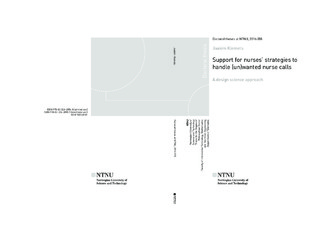| dc.contributor.advisor | Kristiansen, Lill | |
| dc.contributor.advisor | Toussaint, Pieter | |
| dc.contributor.advisor | Evjemo, Tor Erik | |
| dc.contributor.author | Klemets, Joakim | |
| dc.date.accessioned | 2017-01-25T09:58:56Z | |
| dc.date.available | 2017-01-25T09:58:56Z | |
| dc.date.issued | 2016 | |
| dc.identifier.isbn | 978-82-326-2055-5 | |
| dc.identifier.issn | 1503-8181 | |
| dc.identifier.uri | http://hdl.handle.net/11250/2428272 | |
| dc.description.abstract | A nurse call system allows patients in a hospital department to remotely call for a nurse’s assistance when required. Commonly, a nurse call system notifies nurses about an issued call through strategically placed alarm displays. Recently, nurses have also been equipped with wireless phones through which they receive nurse calls. However, nurse call systems have been accused of being a source of continuous interruption that further complicates nurses’ work. In particular, interruptions have been found to negatively affect human cognition and are considered a possible cause to medical errors in this type of working milieu.
Through a design science approach, effort is aimed at designing technology that addresses nurses’ struggles to handle interruptions in the form of nurse calls at aNorwegian university hospital. The research is divided into three distinct yet interdependent phases. In the first phase, the nature of these types of interruptions and nurses’ strategies to handle them are explored using a qualitative case study strategy. In the second phase, engineering methods are applied to develop prototypes that support nurses’ strategies. Finally, during the third phase, nurses are involved in co-design exercises that utilise socio-technical design approaches to further refine the prototypes as well as evaluate their possible implications on practice.
The results indicate that nurse calls are a complex phenomenon that cannot easily be distinguished as having negative or positive effects on nurses’ work. In particular, these calls are an inherent and central part of nursing work, which is supported by the finding that several factors influence nurses’ decision to respond to a nurse call. Nurses were found to adopt four main strategies to both restrict unwanted nurse calls and facilitate the reception ofwanted ones, and prototypes were developed to more efficiently support three of these strategies. The evaluation of the prototypes suggests that these could make existing sub-optimal workarounds redundant, improve work efficiency, and facilitate nurses’ decision making. Further, using this technology to support nurses’ everyday practices that result in successful outcomes could enhance patient safety by strengthening the socio-technical system’s resilience. | nb_NO |
| dc.language.iso | eng | nb_NO |
| dc.publisher | NTNU | nb_NO |
| dc.relation.ispartofseries | Doctoral theses at NTNU;2016:355 | |
| dc.relation.haspart | Paper 1: Klemets, Joakim Henrik M; Evjemo, Tor Erik; Kristiansen, Lill. Designing for Redundancy: Nurses Experiences with the Wireless Nurse Call System. Studies in Health Technology and Informatics 2013.
http://dx.doi.org/10.3233/978-1-61499-289-9-328
This article is published online with Open Access by IOS Press and distributed under the terms of the Creative Commons Attribution Non-Commercial License. | nb_NO |
| dc.relation.haspart | Paper 2: Klemets, Joakim Henrik M; De Moor, Katrien. Patient responsibility reallocation: a user-centered approach to support nurses’ handling of nurse calls. Personal and Ubiquitous Computing 2015 ;Volum 19.(3-4) s. 601-621,
Is not included due to copyright available at
http://dx.doi.org/10.1007/s00779-015-0854-z | nb_NO |
| dc.relation.haspart | Paper 3: Klemets, Joakim Henrik M; Evjemo, Tor Erik. Technology-Mediated Awareness: Facilitating the Handling of (Un)wanted Interruptions in a Hospital Setting. International Journal of Medical Informatics 2014 ;Volum 83.(9) s. 670-682,
http://dx.doi.org/10.1016/j.ijmedinf.2014.06.007
The article is reprinted with kind permission from Elsevier, sciencedirect.com | nb_NO |
| dc.relation.haspart | Paper 4: Klemets, Joakim Henrik M; Toussaint, Pieter Jelle. Availability Communication: Requirements for an Awareness System to Support Nurses' Handling of Nurse Calls. Studies in Health Technology and Informatics 2015 ;Volum 216. s. 103-107,
http://dx.doi.org/10.3233/978-1-61499-564-7-103
This article is published online with Open Access by IOS Press and distributed under the terms
of the Creative Commons Attribution Non-Commercial License. | nb_NO |
| dc.relation.haspart | Paper 5: Klemets, Joakim Henrik M; Toussaint, Pieter Jelle. Does revealing contextual knowledge of the patient’s intention help nurses’ handling of nurse calls?. International Journal of Medical Informatics 2016 ;Volum 86. s. 1-9,
http://dx.doi.org/10.1016/j.ijmedinf.2015.11.010
The article is reprinted with kind permission from Elsevier, sciencedirect.com | nb_NO |
| dc.relation.haspart | Paper 6: Understanding nurses’ strategies to handle (un)wanted nurse calls: a resilience perspective - Is not available due to copyright available at
http://dx.doi.org/10.1097/CIN.0000000000000331 | nb_NO |
| dc.title | Support for nurses’ strategies to handle (un)wanted nurse calls: A design science approach | nb_NO |
| dc.type | Doctoral thesis | nb_NO |
| dc.subject.nsi | VDP::Technology: 500::Information and communication technology: 550::Telecommunication: 552 | nb_NO |

